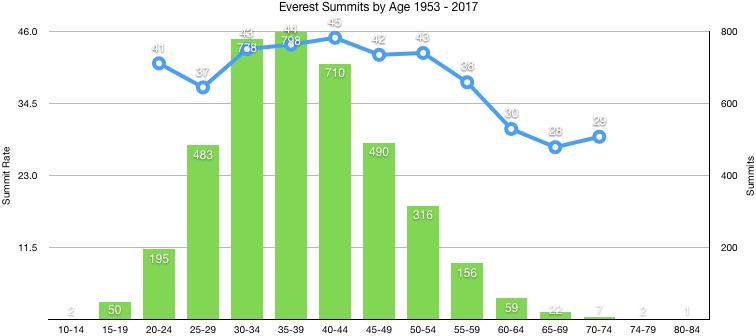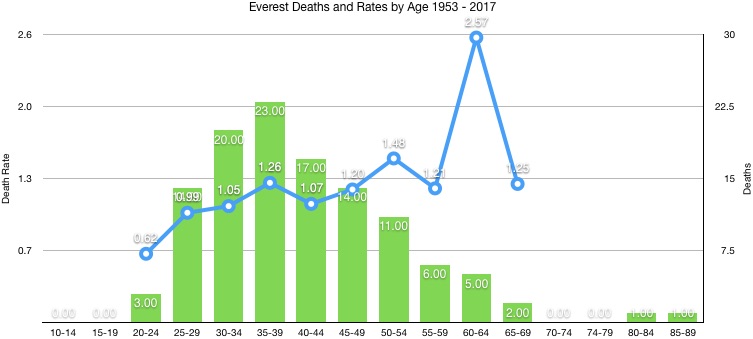It’s busy on Everest just as it should be in late April. We have teams at Camp 2 on the South side and ABC on the North. Ropes are going higher so all is well. In this post I review the action and take a look at the best age to climb Everest.
Icefall Update

We have been hearing all season that the Khumbu Icefall route is in the best shape in years, meaning few ladders (about 7) and reasonably smooth (as much as a moving glacier ever is!), but that doesn’t mean it is without hazards. Remember the Khumbu Icefall starts dropping around 19,000’/5,791m and quickly drops 2,000’/609m over about a mile/1.6km to 17,000/5,181m. In the center it can move up to a meter/3′ a day. See this article I wrote last year detailing the Icefall. In any case, Zac Mahlum, with Mike Hammil’s Climbing the Seven Summits team, made an interesting comment today: “The route this year is one of the best in some time although the Khumbu Icefall has been more active than usual with serac collapses multiple times a day.” Another reference comes from Simon Thomasson”
A constant reminder of the dangers we face are the sporadic avalanches that occur throughout the day and night. Not surprising as we are surrounded on three sides by towering mountains all 6000m+. It was from one of these that as we walked towards our training area that we watched an avalanche cascade across the top third of the Khumbu icefall. Due to the time of day there shouldn’t really have been any reason to be in the icefall and when enquiries were made later there were no reports of anyone being caught up in it.
While this all may sound worrisome for those back home, it’s pretty normal to have small serac release onto the Icefall and seracs topple over. Most of this occurs when the sun is directly hitting the area but as we saw in 2014, it can also happen in the early morning hours. All of this just re-enforces that climbers must move as fast as possible, while being safe, especially crossing the ladders. I can tell you from personal experience, that when you cross the last ladder in the Icefall and hit crampon point, you let out a huge sigh of relief.

Japanese Pride
A surprise climber on the Nepal side is Japanese Nobukazu Kuriki. This is his 7th time on Everest without summiting. Previously the 34-year-old made mostly autumn attempts, solo and without O’s. He has tried from both sides and generally has been stopped by weather and snow conditions. In 2012 he attempted the West Ridge and had to be rescued by a Sherpa team. He lost most of his fingers to frostbite in that attempt. His last attempt was in autumn 2016 from the Tibet side. He planned on the North Face then to the Hornbein Couloir. This year he is hinting at a new route but is not saying what it is. He says he will climb both Everest and Lhotse without supplemental oxygen. As always, he is quite the showman and has a huge following in Japan. I wish him the best this time around. You can follow him on Facebook, Twitter (JP) and his website. He always brings a large film crew along to document his experience, primarily for the Japanese market. They usually post excellent photos of his experience on his social media.

77 Yaks
For whatever reason, I really like this post by Arnold Coster, leading one of the teams for Seven Summits Treks on the Tibet side. It just makes me smile when he says “Today we loaded 77 Yaks with 3080kg of equipment for ABC 6400m” This one doesn’t look very happy!
Adjusting at Chinese Base Camp
This is a nice update from Kari Kobler’s member Andreas Neuschmid.
For a week we acclimatize here now in Everest BC: fixed rope training and walks up to a height of 6.000m alternate with rest days in which we enjoy the luxury of our camp. At 23.4. the yaks will bring our equipment to the Advanced Base Camp (ABC) to 6.400m. There in recent days, the Sherpas have set up under the direction of Kusang Sherpa ABC. We start at 4.24. in the air: The two-day trek to ABC we will stay in the intermediate camp at 5.700m once.
It’s important to be patient and not rush up the Hill once you get to base camp. Usually teams on both sides will take three to five days just to let them bodies slowly adjust, and often that includes those who “pre-acclimitized”. Strong professional climbers and guides might not take as long but people who do not climb for a living need to pay attention to their bodies and be smart.
Another “adjustment” teams must make on the Tibet side is the constant supervision by the Chinese Mountaineering Association. I found this comment interesting from Jacek Jasniewski: “Today was last day in Everest Base Camp at 5200 m. In China Camp we can’t not use national flags, but others why not. Behind me Everest in the cloud and strong wind. Tomorrow we will go more up.” Click on his name to see the photo he posted.
The Best Age to Climb Everest
This season we are seeing climbers ranging in age from 16 to 79. I often get questions that start with “I’m 45 years-old, probably too old to climb Everest but …” If I can use myself as an example for a moment, my first attempt on Everest was at age 46. I was too young and ambitious for my own good 🙂 🙂 🙂 I tried two more times at ages 47 and 52 and finally made it on my fourth try at the ripe age of wisdom 🙂 🙂 54. So I always tell people to never think age is the limiting factor. My good friend Bill Burke summited twice at ages 67 and 72!
With all this in mind, I did a deep dive with the Himalayan Database on how summit success, and death rates span ages. The charts are for the normal routes on both sides from 1953 to 2017 for members only. I didn’t analysis Sherpas because the vast majority are in their 20’s to early 30’s. As you can see, ages 25 to 50 represent 80% of the summits with 30 to 39 dominating and the success rate decreases with age, especially after 55. The average summit age is 38. As for death rates by age, it increases with age. The 25-29 group has a death rate of 0.99 compared to the 50 to 54 group at 1.48. The over 60 and under 25 stats are too small to be significant.


As for the oldest person, Japanese Miura Yiuchiro, age 80 on May 23, 2013 holds that record. The oldest female ever to summit was Japanese Tamae Watanabe, age 73, in 2012 from the North. The youngest female to the summit was Indian Malavath Poorna, 13 years 11 months on May 25, 2014 from the north side. The youngest person ever to summit was American Jordan Romero, age 13 years 11 months, on May 23, 2010 from the North side. You have to be 16 or older to climb from the Nepal side with no upper age limit and between 18 and 70 on the Chinese side. Age limits were set after Romero and Poorna made their summits.
Kanchenjunga Progress
In the yesterday’s post, I gave an overview of all the other 8000ers being climbed this spring and wanted to pass on this encouraging news from Dawa Steven Sherpa of Asian Trekking. He tells me “Just wanted to let you know that our Sherpas managed to open up camp 3 on Kanchenjunga today and even managed to get a little higher. This year Asian Trekking has 21 members and 26 Sherpas on Kanchenjunga. 8 of the Sherpas are specifically for rope fixing. We are targeting an early summit this season if the weather allows!”
This is fantastic given last year climbers missed the summit by a few hundred meters when they ran out of rope.
Climb On!
Alan
Memories are Everything



5 thoughts on “Everest 2018: The Right Age for Everest”
Interesting reading Alan. As always 🙂 Do you know if Kenton Kool with Ben Fogle and Victoria Pendleton are leaving updates on blogs or facebook?
They are updating their Instagram accounts ?
https://www.instagram.com/p/Bh3khx4hiZY/
https://www.instagram.com/benfogle/
https://twitter.com/KentonCool
Alan – as always – another great post and some great insight into climbing on Everest. I’ve got a personal goal of attempting Everest by the time I’m 50. Have 10 years to make the dream a reality! Thanks again for all the information you provide on this blog…it is great to read about your adventures and also see what is going on every day half way around the world.
Thanks Mike. One of the reason I dug into this was to prove the point that people can attempt Everest “later in life” 🙂 50 is the new 49 so go for it!
Comments are closed.